A Literature Review on the Use of Customer Relationship Management
VerifiedAdded on 2023/01/10
|7
|1926
|61
Literature Review
AI Summary
This literature review examines the use of Customer Relationship Management (CRM) systems, exploring their impact on business relationships, customer satisfaction, and overall profitability. The review synthesizes perspectives from various authors, journals, and books, defining CRM as a technology for managing customer interactions and streamlining processes. It covers CRM's role in contact management, sales, marketing, and customer service, highlighting the benefits of CRM software, cloud solutions, and AI integration. The report discusses CRM's functionality in data aggregation, automated procedures, and real-time data access, emphasizing its contribution to efficient communication, sales team support, and customer service operations. The review also explores CRM's role in revenue maximization, customer profiling, and aligning sales and marketing teams. The report concludes with a summary of the benefits of CRM for businesses, including improved customer understanding, targeted marketing, and enhanced customer relations.
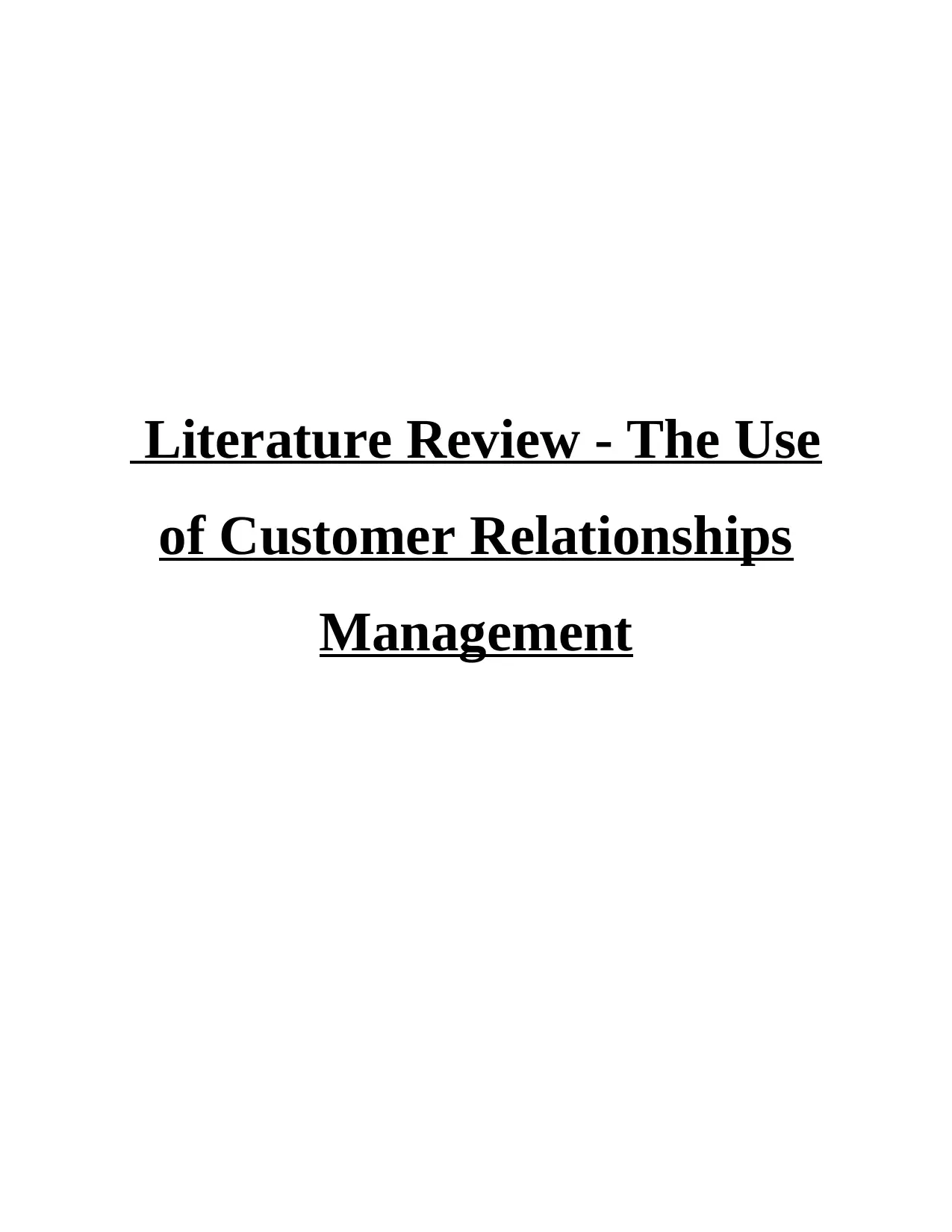
Literature Review - The Use
of Customer Relationships
Management
of Customer Relationships
Management
Paraphrase This Document
Need a fresh take? Get an instant paraphrase of this document with our AI Paraphraser
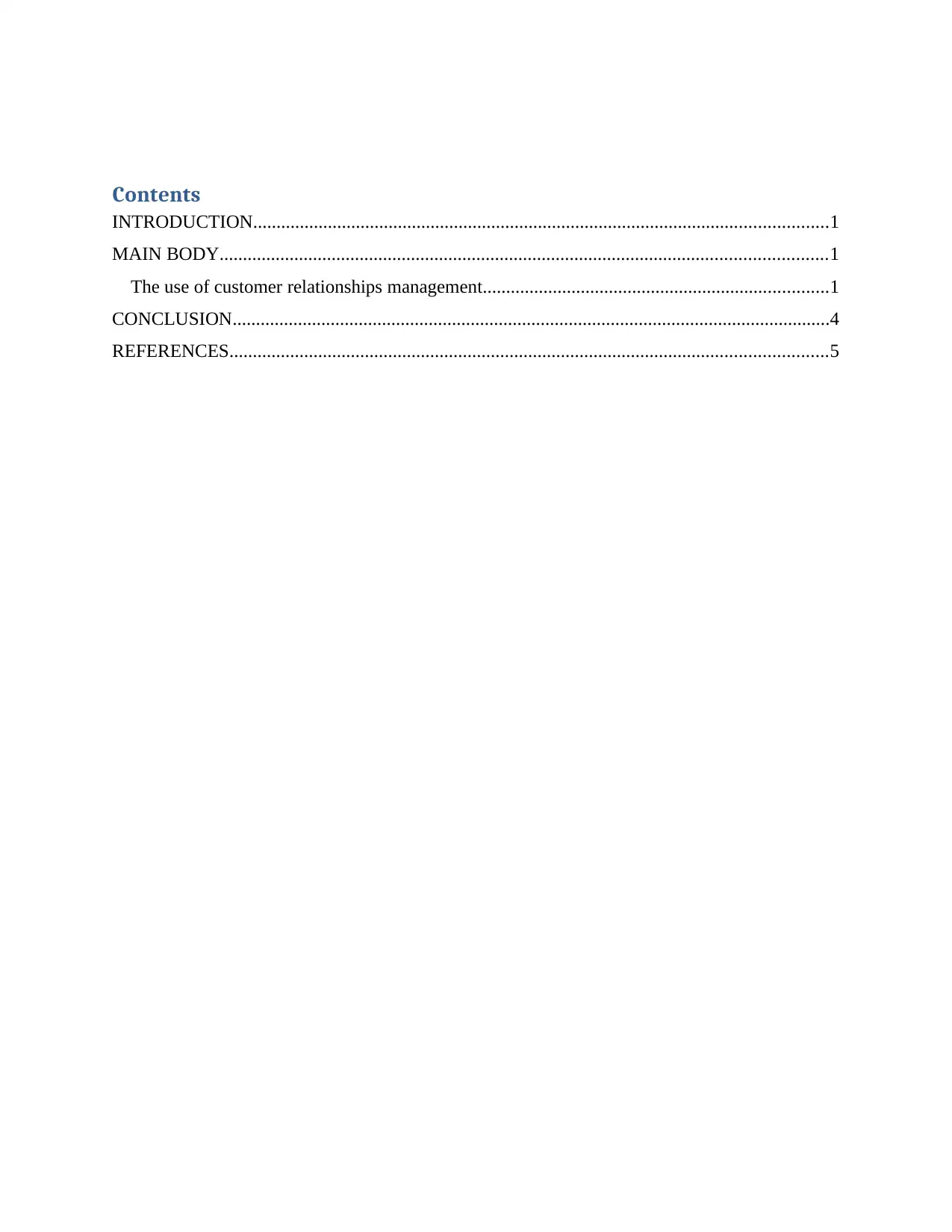
Contents
INTRODUCTION...........................................................................................................................1
MAIN BODY..................................................................................................................................1
The use of customer relationships management..........................................................................1
CONCLUSION................................................................................................................................4
REFERENCES................................................................................................................................5
INTRODUCTION...........................................................................................................................1
MAIN BODY..................................................................................................................................1
The use of customer relationships management..........................................................................1
CONCLUSION................................................................................................................................4
REFERENCES................................................................................................................................5
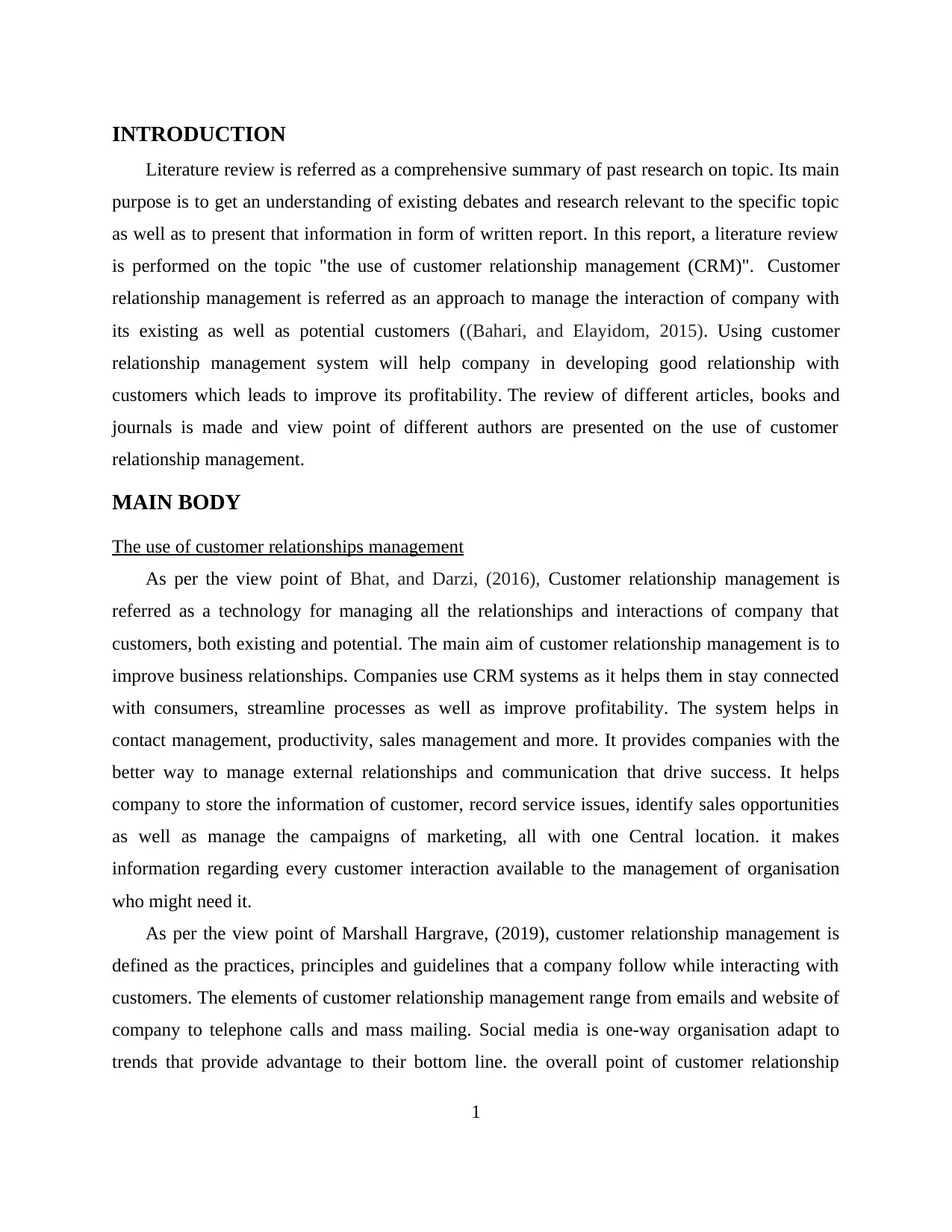
INTRODUCTION
Literature review is referred as a comprehensive summary of past research on topic. Its main
purpose is to get an understanding of existing debates and research relevant to the specific topic
as well as to present that information in form of written report. In this report, a literature review
is performed on the topic "the use of customer relationship management (CRM)". Customer
relationship management is referred as an approach to manage the interaction of company with
its existing as well as potential customers ((Bahari, and Elayidom, 2015). Using customer
relationship management system will help company in developing good relationship with
customers which leads to improve its profitability. The review of different articles, books and
journals is made and view point of different authors are presented on the use of customer
relationship management.
MAIN BODY
The use of customer relationships management
As per the view point of Bhat, and Darzi, (2016), Customer relationship management is
referred as a technology for managing all the relationships and interactions of company that
customers, both existing and potential. The main aim of customer relationship management is to
improve business relationships. Companies use CRM systems as it helps them in stay connected
with consumers, streamline processes as well as improve profitability. The system helps in
contact management, productivity, sales management and more. It provides companies with the
better way to manage external relationships and communication that drive success. It helps
company to store the information of customer, record service issues, identify sales opportunities
as well as manage the campaigns of marketing, all with one Central location. it makes
information regarding every customer interaction available to the management of organisation
who might need it.
As per the view point of Marshall Hargrave, (2019), customer relationship management is
defined as the practices, principles and guidelines that a company follow while interacting with
customers. The elements of customer relationship management range from emails and website of
company to telephone calls and mass mailing. Social media is one-way organisation adapt to
trends that provide advantage to their bottom line. the overall point of customer relationship
1
Literature review is referred as a comprehensive summary of past research on topic. Its main
purpose is to get an understanding of existing debates and research relevant to the specific topic
as well as to present that information in form of written report. In this report, a literature review
is performed on the topic "the use of customer relationship management (CRM)". Customer
relationship management is referred as an approach to manage the interaction of company with
its existing as well as potential customers ((Bahari, and Elayidom, 2015). Using customer
relationship management system will help company in developing good relationship with
customers which leads to improve its profitability. The review of different articles, books and
journals is made and view point of different authors are presented on the use of customer
relationship management.
MAIN BODY
The use of customer relationships management
As per the view point of Bhat, and Darzi, (2016), Customer relationship management is
referred as a technology for managing all the relationships and interactions of company that
customers, both existing and potential. The main aim of customer relationship management is to
improve business relationships. Companies use CRM systems as it helps them in stay connected
with consumers, streamline processes as well as improve profitability. The system helps in
contact management, productivity, sales management and more. It provides companies with the
better way to manage external relationships and communication that drive success. It helps
company to store the information of customer, record service issues, identify sales opportunities
as well as manage the campaigns of marketing, all with one Central location. it makes
information regarding every customer interaction available to the management of organisation
who might need it.
As per the view point of Marshall Hargrave, (2019), customer relationship management is
defined as the practices, principles and guidelines that a company follow while interacting with
customers. The elements of customer relationship management range from emails and website of
company to telephone calls and mass mailing. Social media is one-way organisation adapt to
trends that provide advantage to their bottom line. the overall point of customer relationship
1
⊘ This is a preview!⊘
Do you want full access?
Subscribe today to unlock all pages.

Trusted by 1+ million students worldwide
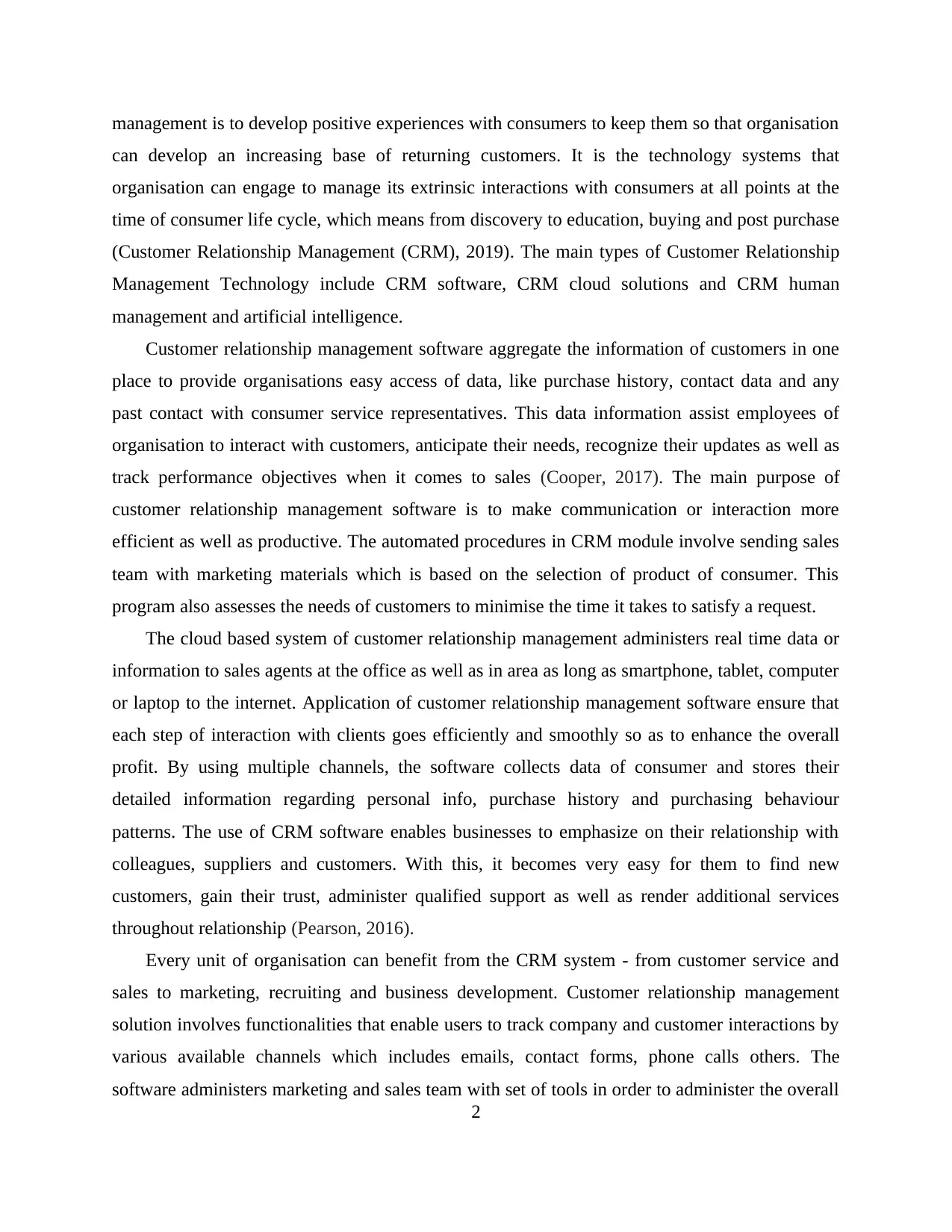
management is to develop positive experiences with consumers to keep them so that organisation
can develop an increasing base of returning customers. It is the technology systems that
organisation can engage to manage its extrinsic interactions with consumers at all points at the
time of consumer life cycle, which means from discovery to education, buying and post purchase
(Customer Relationship Management (CRM), 2019). The main types of Customer Relationship
Management Technology include CRM software, CRM cloud solutions and CRM human
management and artificial intelligence.
Customer relationship management software aggregate the information of customers in one
place to provide organisations easy access of data, like purchase history, contact data and any
past contact with consumer service representatives. This data information assist employees of
organisation to interact with customers, anticipate their needs, recognize their updates as well as
track performance objectives when it comes to sales (Cooper, 2017). The main purpose of
customer relationship management software is to make communication or interaction more
efficient as well as productive. The automated procedures in CRM module involve sending sales
team with marketing materials which is based on the selection of product of consumer. This
program also assesses the needs of customers to minimise the time it takes to satisfy a request.
The cloud based system of customer relationship management administers real time data or
information to sales agents at the office as well as in area as long as smartphone, tablet, computer
or laptop to the internet. Application of customer relationship management software ensure that
each step of interaction with clients goes efficiently and smoothly so as to enhance the overall
profit. By using multiple channels, the software collects data of consumer and stores their
detailed information regarding personal info, purchase history and purchasing behaviour
patterns. The use of CRM software enables businesses to emphasize on their relationship with
colleagues, suppliers and customers. With this, it becomes very easy for them to find new
customers, gain their trust, administer qualified support as well as render additional services
throughout relationship (Pearson, 2016).
Every unit of organisation can benefit from the CRM system - from customer service and
sales to marketing, recruiting and business development. Customer relationship management
solution involves functionalities that enable users to track company and customer interactions by
various available channels which includes emails, contact forms, phone calls others. The
software administers marketing and sales team with set of tools in order to administer the overall
2
can develop an increasing base of returning customers. It is the technology systems that
organisation can engage to manage its extrinsic interactions with consumers at all points at the
time of consumer life cycle, which means from discovery to education, buying and post purchase
(Customer Relationship Management (CRM), 2019). The main types of Customer Relationship
Management Technology include CRM software, CRM cloud solutions and CRM human
management and artificial intelligence.
Customer relationship management software aggregate the information of customers in one
place to provide organisations easy access of data, like purchase history, contact data and any
past contact with consumer service representatives. This data information assist employees of
organisation to interact with customers, anticipate their needs, recognize their updates as well as
track performance objectives when it comes to sales (Cooper, 2017). The main purpose of
customer relationship management software is to make communication or interaction more
efficient as well as productive. The automated procedures in CRM module involve sending sales
team with marketing materials which is based on the selection of product of consumer. This
program also assesses the needs of customers to minimise the time it takes to satisfy a request.
The cloud based system of customer relationship management administers real time data or
information to sales agents at the office as well as in area as long as smartphone, tablet, computer
or laptop to the internet. Application of customer relationship management software ensure that
each step of interaction with clients goes efficiently and smoothly so as to enhance the overall
profit. By using multiple channels, the software collects data of consumer and stores their
detailed information regarding personal info, purchase history and purchasing behaviour
patterns. The use of CRM software enables businesses to emphasize on their relationship with
colleagues, suppliers and customers. With this, it becomes very easy for them to find new
customers, gain their trust, administer qualified support as well as render additional services
throughout relationship (Pearson, 2016).
Every unit of organisation can benefit from the CRM system - from customer service and
sales to marketing, recruiting and business development. Customer relationship management
solution involves functionalities that enable users to track company and customer interactions by
various available channels which includes emails, contact forms, phone calls others. The
software administers marketing and sales team with set of tools in order to administer the overall
2
Paraphrase This Document
Need a fresh take? Get an instant paraphrase of this document with our AI Paraphraser
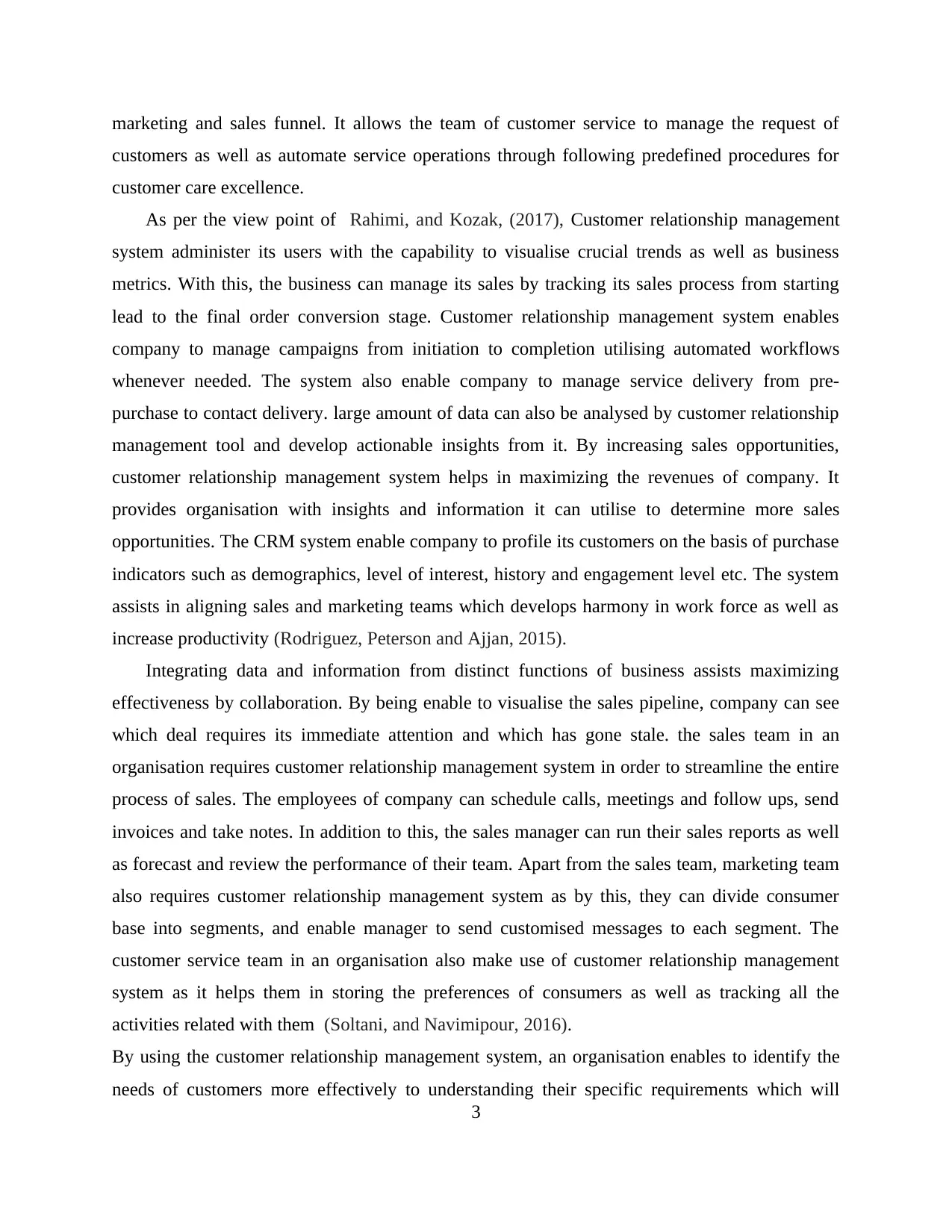
marketing and sales funnel. It allows the team of customer service to manage the request of
customers as well as automate service operations through following predefined procedures for
customer care excellence.
As per the view point of Rahimi, and Kozak, (2017), Customer relationship management
system administer its users with the capability to visualise crucial trends as well as business
metrics. With this, the business can manage its sales by tracking its sales process from starting
lead to the final order conversion stage. Customer relationship management system enables
company to manage campaigns from initiation to completion utilising automated workflows
whenever needed. The system also enable company to manage service delivery from pre-
purchase to contact delivery. large amount of data can also be analysed by customer relationship
management tool and develop actionable insights from it. By increasing sales opportunities,
customer relationship management system helps in maximizing the revenues of company. It
provides organisation with insights and information it can utilise to determine more sales
opportunities. The CRM system enable company to profile its customers on the basis of purchase
indicators such as demographics, level of interest, history and engagement level etc. The system
assists in aligning sales and marketing teams which develops harmony in work force as well as
increase productivity (Rodriguez, Peterson and Ajjan, 2015).
Integrating data and information from distinct functions of business assists maximizing
effectiveness by collaboration. By being enable to visualise the sales pipeline, company can see
which deal requires its immediate attention and which has gone stale. the sales team in an
organisation requires customer relationship management system in order to streamline the entire
process of sales. The employees of company can schedule calls, meetings and follow ups, send
invoices and take notes. In addition to this, the sales manager can run their sales reports as well
as forecast and review the performance of their team. Apart from the sales team, marketing team
also requires customer relationship management system as by this, they can divide consumer
base into segments, and enable manager to send customised messages to each segment. The
customer service team in an organisation also make use of customer relationship management
system as it helps them in storing the preferences of consumers as well as tracking all the
activities related with them (Soltani, and Navimipour, 2016).
By using the customer relationship management system, an organisation enables to identify the
needs of customers more effectively to understanding their specific requirements which will
3
customers as well as automate service operations through following predefined procedures for
customer care excellence.
As per the view point of Rahimi, and Kozak, (2017), Customer relationship management
system administer its users with the capability to visualise crucial trends as well as business
metrics. With this, the business can manage its sales by tracking its sales process from starting
lead to the final order conversion stage. Customer relationship management system enables
company to manage campaigns from initiation to completion utilising automated workflows
whenever needed. The system also enable company to manage service delivery from pre-
purchase to contact delivery. large amount of data can also be analysed by customer relationship
management tool and develop actionable insights from it. By increasing sales opportunities,
customer relationship management system helps in maximizing the revenues of company. It
provides organisation with insights and information it can utilise to determine more sales
opportunities. The CRM system enable company to profile its customers on the basis of purchase
indicators such as demographics, level of interest, history and engagement level etc. The system
assists in aligning sales and marketing teams which develops harmony in work force as well as
increase productivity (Rodriguez, Peterson and Ajjan, 2015).
Integrating data and information from distinct functions of business assists maximizing
effectiveness by collaboration. By being enable to visualise the sales pipeline, company can see
which deal requires its immediate attention and which has gone stale. the sales team in an
organisation requires customer relationship management system in order to streamline the entire
process of sales. The employees of company can schedule calls, meetings and follow ups, send
invoices and take notes. In addition to this, the sales manager can run their sales reports as well
as forecast and review the performance of their team. Apart from the sales team, marketing team
also requires customer relationship management system as by this, they can divide consumer
base into segments, and enable manager to send customised messages to each segment. The
customer service team in an organisation also make use of customer relationship management
system as it helps them in storing the preferences of consumers as well as tracking all the
activities related with them (Soltani, and Navimipour, 2016).
By using the customer relationship management system, an organisation enables to identify the
needs of customers more effectively to understanding their specific requirements which will
3
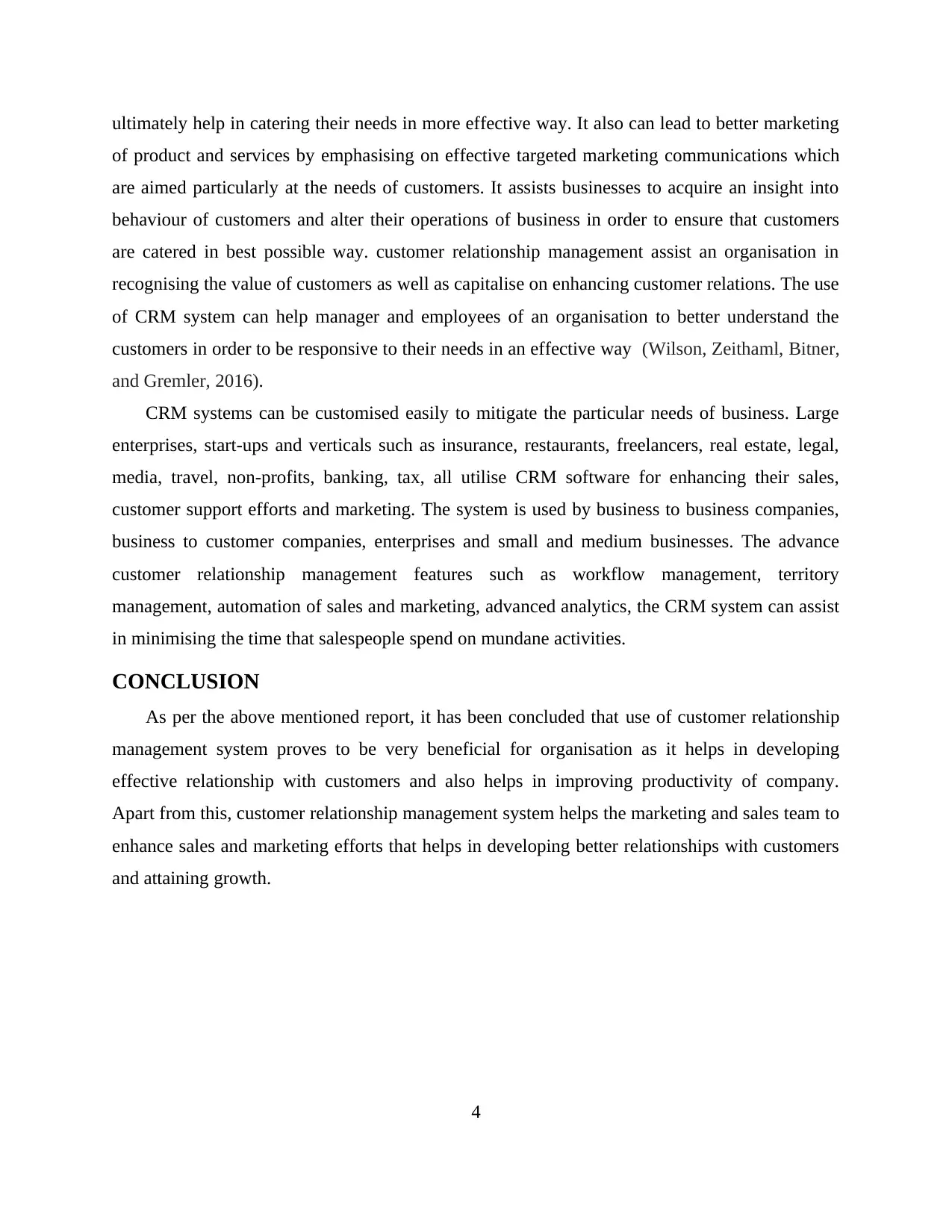
ultimately help in catering their needs in more effective way. It also can lead to better marketing
of product and services by emphasising on effective targeted marketing communications which
are aimed particularly at the needs of customers. It assists businesses to acquire an insight into
behaviour of customers and alter their operations of business in order to ensure that customers
are catered in best possible way. customer relationship management assist an organisation in
recognising the value of customers as well as capitalise on enhancing customer relations. The use
of CRM system can help manager and employees of an organisation to better understand the
customers in order to be responsive to their needs in an effective way (Wilson, Zeithaml, Bitner,
and Gremler, 2016).
CRM systems can be customised easily to mitigate the particular needs of business. Large
enterprises, start-ups and verticals such as insurance, restaurants, freelancers, real estate, legal,
media, travel, non-profits, banking, tax, all utilise CRM software for enhancing their sales,
customer support efforts and marketing. The system is used by business to business companies,
business to customer companies, enterprises and small and medium businesses. The advance
customer relationship management features such as workflow management, territory
management, automation of sales and marketing, advanced analytics, the CRM system can assist
in minimising the time that salespeople spend on mundane activities.
CONCLUSION
As per the above mentioned report, it has been concluded that use of customer relationship
management system proves to be very beneficial for organisation as it helps in developing
effective relationship with customers and also helps in improving productivity of company.
Apart from this, customer relationship management system helps the marketing and sales team to
enhance sales and marketing efforts that helps in developing better relationships with customers
and attaining growth.
4
of product and services by emphasising on effective targeted marketing communications which
are aimed particularly at the needs of customers. It assists businesses to acquire an insight into
behaviour of customers and alter their operations of business in order to ensure that customers
are catered in best possible way. customer relationship management assist an organisation in
recognising the value of customers as well as capitalise on enhancing customer relations. The use
of CRM system can help manager and employees of an organisation to better understand the
customers in order to be responsive to their needs in an effective way (Wilson, Zeithaml, Bitner,
and Gremler, 2016).
CRM systems can be customised easily to mitigate the particular needs of business. Large
enterprises, start-ups and verticals such as insurance, restaurants, freelancers, real estate, legal,
media, travel, non-profits, banking, tax, all utilise CRM software for enhancing their sales,
customer support efforts and marketing. The system is used by business to business companies,
business to customer companies, enterprises and small and medium businesses. The advance
customer relationship management features such as workflow management, territory
management, automation of sales and marketing, advanced analytics, the CRM system can assist
in minimising the time that salespeople spend on mundane activities.
CONCLUSION
As per the above mentioned report, it has been concluded that use of customer relationship
management system proves to be very beneficial for organisation as it helps in developing
effective relationship with customers and also helps in improving productivity of company.
Apart from this, customer relationship management system helps the marketing and sales team to
enhance sales and marketing efforts that helps in developing better relationships with customers
and attaining growth.
4
⊘ This is a preview!⊘
Do you want full access?
Subscribe today to unlock all pages.

Trusted by 1+ million students worldwide
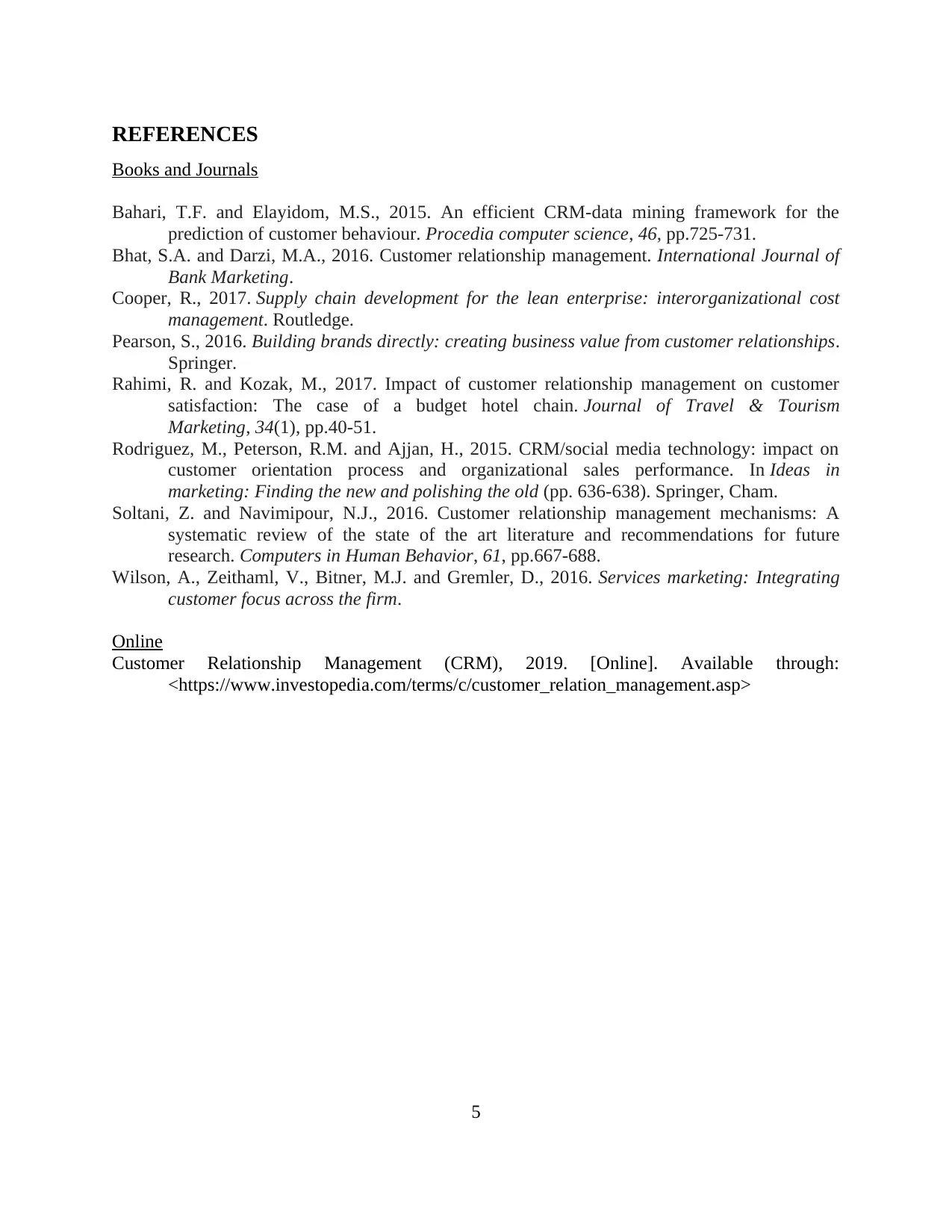
REFERENCES
Books and Journals
Bahari, T.F. and Elayidom, M.S., 2015. An efficient CRM-data mining framework for the
prediction of customer behaviour. Procedia computer science, 46, pp.725-731.
Bhat, S.A. and Darzi, M.A., 2016. Customer relationship management. International Journal of
Bank Marketing.
Cooper, R., 2017. Supply chain development for the lean enterprise: interorganizational cost
management. Routledge.
Pearson, S., 2016. Building brands directly: creating business value from customer relationships.
Springer.
Rahimi, R. and Kozak, M., 2017. Impact of customer relationship management on customer
satisfaction: The case of a budget hotel chain. Journal of Travel & Tourism
Marketing, 34(1), pp.40-51.
Rodriguez, M., Peterson, R.M. and Ajjan, H., 2015. CRM/social media technology: impact on
customer orientation process and organizational sales performance. In Ideas in
marketing: Finding the new and polishing the old (pp. 636-638). Springer, Cham.
Soltani, Z. and Navimipour, N.J., 2016. Customer relationship management mechanisms: A
systematic review of the state of the art literature and recommendations for future
research. Computers in Human Behavior, 61, pp.667-688.
Wilson, A., Zeithaml, V., Bitner, M.J. and Gremler, D., 2016. Services marketing: Integrating
customer focus across the firm.
Online
Customer Relationship Management (CRM), 2019. [Online]. Available through:
<https://www.investopedia.com/terms/c/customer_relation_management.asp>
5
Books and Journals
Bahari, T.F. and Elayidom, M.S., 2015. An efficient CRM-data mining framework for the
prediction of customer behaviour. Procedia computer science, 46, pp.725-731.
Bhat, S.A. and Darzi, M.A., 2016. Customer relationship management. International Journal of
Bank Marketing.
Cooper, R., 2017. Supply chain development for the lean enterprise: interorganizational cost
management. Routledge.
Pearson, S., 2016. Building brands directly: creating business value from customer relationships.
Springer.
Rahimi, R. and Kozak, M., 2017. Impact of customer relationship management on customer
satisfaction: The case of a budget hotel chain. Journal of Travel & Tourism
Marketing, 34(1), pp.40-51.
Rodriguez, M., Peterson, R.M. and Ajjan, H., 2015. CRM/social media technology: impact on
customer orientation process and organizational sales performance. In Ideas in
marketing: Finding the new and polishing the old (pp. 636-638). Springer, Cham.
Soltani, Z. and Navimipour, N.J., 2016. Customer relationship management mechanisms: A
systematic review of the state of the art literature and recommendations for future
research. Computers in Human Behavior, 61, pp.667-688.
Wilson, A., Zeithaml, V., Bitner, M.J. and Gremler, D., 2016. Services marketing: Integrating
customer focus across the firm.
Online
Customer Relationship Management (CRM), 2019. [Online]. Available through:
<https://www.investopedia.com/terms/c/customer_relation_management.asp>
5
1 out of 7
Related Documents
Your All-in-One AI-Powered Toolkit for Academic Success.
+13062052269
info@desklib.com
Available 24*7 on WhatsApp / Email
![[object Object]](/_next/static/media/star-bottom.7253800d.svg)
Unlock your academic potential
Copyright © 2020–2025 A2Z Services. All Rights Reserved. Developed and managed by ZUCOL.





